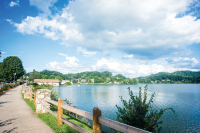Cashing in on adventure: Outdoor recreation economy launches strong pandemic rebound
 A cyclist goes bike packing on Ivestor Gap Trail in the Pisgah National Forest. Industry Nine photo
A cyclist goes bike packing on Ivestor Gap Trail in the Pisgah National Forest. Industry Nine photo
New data from the U.S. Department of Commerce’s Bureau of Economic Analysis show that 2021 was a year of growth for the outdoor economy in North Carolina — but that the industry is still working to make up ground it lost during the pandemic.
Despite challenges related to inflation, workforce and supply chains, total outdoor recreation spending in North Carolina rose 22.6% over 2020 numbers, outpacing the national average of 21.7% growth, according to BEA’s Outdoor Recreation Satellite Account. The industry accounts for 1.8% of North Carolina’s gross domestic product and employs more than 130,000 people. This is 2.7% of North Carolina’s total wage and salary employment and 1.7% of total compensation.
Nationally, outdoor recreation generates $862 billion in economic output, accounting for 3% of U.S. wage and salary employment and supporting more than 4.5 million jobs.
“This new data shows that the outdoor recreation sector continues to be a powerful economic force in North Carolina,” said Amy Allison, director of the Made by Mountains Partnership. “By investing in public lands and infrastructure, building outdoor-centric communities and supporting outdoor recreation businesses and entrepreneurs, we continue to advance North Carolina’s status as the Outdoor Industry Capital of the East.”

- Hikers explore a trail in Cherokee. Bear Allison photo
Robust rebound
The new data indicate growth in 2021 compared to 2020 numbers. However, the industry has not yet fully rebounded to 2019 levels — in either North Carolina or in the country as a whole.
Related Items
In 2019, the outdoor recreation industry contributed $459 billion to the U.S. economy, and $12 billion in North Carolina. Those numbers plummeted to $374 billion and $10 billion, respectively, in 2020 and only partially rebounded in 2021, clocking in at $454 billion nationwide and $11.8 billion for North Carolina.
Likewise, while the 130,000 jobs the industry supported in North Carolina in 2021 is an increase from the 123,000 recorded in the 2020 report, it’s markedly less than the nearly 152,000 jobs reported in 2019. In that year, outdoor recreation jobs accounted for 1.8% of North Carolina’s total compensation, more than 2021’s 1.7% share.
However, the momentum is now toward growth. Inflation-adjusted GDP for the nation’s outdoor recreation economy increased 18.9% in 2021, compared with a 5.9% increase for the overall U.S. economy. This reflects a rebound in outdoor recreation after a 21.6% decrease in 2020. Real gross output for the outdoor recreation economy increased 21.7%, while outdoor recreation compensation increased 16.2% and employment increased 13.1% compared to 2020.
This upward trend is in full force in North Carolina, which ranked nineth among all states on employment growth with a 13.8% increase, outpacing the 13% nationwide average. The state also outpaced national averages on compensation, with 17.2% in annual growth compared to a national increase of 16.2%.
North Carolina ranks 11th among the 50 states for total value added by outdoor recreation to the state’s economy. That’s one step down from the 10th-place ranking North Carolina maintained in 2019 and 2020, with the demotion due to a surge in outdoor recreation growth from Indiana. That state ranked 13th in 2019 and 11th in 2020 but rushed forward to claim eighth place in 2021.
North Carolina’s 11th place ranking roughly tracks with its place as the nineth most populous state, but its prominence in the outdoor recreation economy far outstrips its status as the 29th largest state by land area.

- Rafters navigate a section of the French Broad River. French Broad Adventures photo
Keeping the growth going
There’s no debate that the mountain region is a heavy contributor to North Carolina’s outdoor economy. The region contains two of the most-visited units in the National Parks System — the Great Smoky Mountains National Park and the Blue Ridge Parkway — as well as the Pisgah and Nantahala national forests, some of the nation’s most-visited U.S. Forest Service lands.
According to a report from the U.S. Park Service and U.S. Geological Survey, national parks — principally the Smokies and the Parkway — contributed $2.6 billion to the state’s economy in 2021. Park visitors spent $1.7 billion in local gateway towns, and these expenditures supported nearly 25,000 jobs, $871 million in labor income and $1.4 billion in value added, with $2.6 billion in economic output in the North Carolina economy.
But the state’s other regions also draw outdoor enthusiasts. The coastal region offers a bounty of beach and ocean-based recreation and is home to the Croatan National Forest, while the Uwharrie National Forest is located in the Piedmont. State parks, game lands and other public lands can be found throughout the state.
According to the BEA data, North Carolina saw tremendous growth in value added from RV use between 2020 and 2021, with a 20% increase, and unsurprisingly an even bigger increase in value added from festivals and amusements parks compared to 2020, when pandemic restrictions were in full force. Festivals, sporting events and concerts contributed nearly 50% more to the economy in 2021 than in 2020, with amusement parks and water parks posting a 44% increase.
“Conventional” outdoor recreation like biking, boating, hiking and hunting saw a more modest 17% year-over-year increase, but these activities were less impacted by pandemic restrictions. Supporting activities like construction, travel and tourism, local trips and government spending grew 21%.
Cycling, boating and fishing, canoeing and kayaking, hiking and camping, hunting, shooting and trapping, and other outdoor recreational activities have all seen consistent year-over-year growth in economic impact and participation, said Allison. This includes impressive gains from 2020 to 2021 as access, opportunities and statewide outdoor investment have expanded.
Formed in 2021, Made By Mountains is a partnership focusing on the outdoor economy in the western part of the state, working to expand this economic sector across North Carolina’s Appalachian region and catalyze regional development by building vibrant communities, driving outdoor industry growth and empowering regional storytelling.
It’s currently in the midst of a two-year program called Building Outdoor Communities that aims to help individual communities foster collaboration and expertise to meet their outdoor economy goals. More than 130 people from 25 western counties met in Boone for a kickoff event in September. Now, the counties have been divided into three cohorts that will spend the coming years understanding what their outdoor-based economy needs to function and how to put those pieces together. Allison expects the effort to extend beyond the initial two years — she sees that time period as the first step of an ongoing process to support WNC communities as they “connect the dots between trail and economic development.”
“The Made By Mountains Partnership will continue to work to support the growth of the outdoor recreation economy so that the outdoor sector remains a pillar of the region’s economic prosperity,” she said. “Access to public lands is fundamental for economic vitality, as well as communities’ and residents’ health and wellness. Outdoor recreation continues to be a driving force for entrepreneurship, workforce development, talent retention and recruitment, and the cultivation of thriving outdoor recreation communities.”
By the numbers
• $11.8 billion in economic value from N.C.’s outdoor recreation industry in 2021
• 130,000 jobs supported by N.C. outdoor recreation industry in 2021
• 11th largest outdoor recreation value of any U.S. state in 2021
• 18.9% inflation-adjusted growth for U.S. outdoor recreation economy in 2021
• 5.9% inflation-adjusted growth for overall U.S. economy in 2021
• 21.6% outdoor recreation economy decrease in 2020
Source: U.S. Bureau of Economic Analysis 2021 Outdoor Recreation Satellite Account. More information at bea.gov/news/2022/outdoor-recreation-satellite-account-us-and-states-2021.









